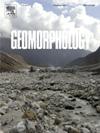“Fault dynamics and paleoseismic evidence in the Darjeeling-Sikkim Himalayan foothills: A study of fault-controlled landscapes”
IF 3.1
2区 地球科学
Q2 GEOGRAPHY, PHYSICAL
引用次数: 0
Abstract
The Darjeeling-Sikkim Himalayan foothills exhibit a dynamic interaction of regional thrusts, back thrusts, and transverse faults, facilitating strain adjustments. The back-thrust system is characterized by the hinterland-sloping Thaljhora, Nagrakata, and Baradighi scarps, while the transverse faults are controlling river courses, including the Neora, Murti, Jaldhaka, Gathia, and Jiti. This region, known as the Jaldhaka recess, shows evidence of active deformation.
Analyses of slope and longitudinal profiles of rivers and fan surfaces suggest folding in Thaljhora and Baradighi surfaces, with major rivers forming prominent knickpoints as they cross scarps related to back thrusts. A parallel river network further indicates transverse fault-controlled drainage. A trench excavation perpendicular to the Thaljhora scarp, supplemented by natural outcrops, revealed sediment deformations linked to a southerly dipping back thrust fault. Soft Sediment Deformation Structures, which we consider as seismites, indicate moderate-magnitude earthquakes intermittently activated by Thaljhora back thrust.
The radiocarbon age of deformed carbonaceous clays suggests a significant uplift along the Thaljhora thrust between ∼31,000 and ∼ 28,000 CalBP. Another activation phase occurred around ∼21,000 CalBP, forming the Baradighi scarp, with reactivation at ∼9000 CalBP. The Nagrakata scarp likely resulted from rotational movement and strain adjustments among the Thaljhora backthrust and the transverse Jaldhaka and Gathia faults. Thus, evidence from river profiles, trench excavations, and dating techniques (radiocarbon and OSL) confirms late Pleistocene seismic activity, with at least two significant earthquakes (Mw 6–7) influencing fault movements and landscape evolution.
“大吉-锡金喜马拉雅山麓断层动力学与古地震证据:断层控制景观研究”
大吉-锡金喜马拉雅山麓表现出区域逆冲、逆冲和横向断层的动态相互作用,有利于应变调整。逆冲构造的腹地以塔里霍拉(Thaljhora)、Nagrakata (Nagrakata)和巴拉迪吉(Baradighi)陡坡为特征,横向断裂控制着Neora、Murti、Jaldhaka、Gathia和Jiti等河道。这个地区被称为贾达卡隐窝,显示出活跃变形的证据。对河流和扇面坡度和纵向剖面的分析表明,在Thaljhora和Baradighi表面存在褶皱,主要河流在穿过与逆冲相关的陡坡时形成了突出的裂缝点。平行河网进一步表明横向断层控制排水。一个垂直于Thaljhora陡崖的沟槽挖掘,加上自然露头,揭示了与南倾逆冲断层有关的沉积物变形。软沉积变形构造,我们认为是震积岩,表明中震级地震间歇性地由Thaljhora逆冲激活。变形的碳质粘土的放射性碳年龄表明,在~ 31,000和~ 28,000 CalBP之间,沿Thaljhora逆冲构造有明显的隆起。另一个激活阶段发生在~ 21,000 CalBP左右,形成Baradighi陡坡,在~ 9000 CalBP再次激活。长田断崖的形成可能是由于塔里霍拉逆冲断层与横向的贾尔达卡断层和加西亚断层之间的旋转运动和应变调整所致。因此,来自河流剖面、沟槽挖掘和测年技术(放射性碳和OSL)的证据证实了晚更新世的地震活动,至少有两次重大地震(Mw 6-7)影响了断层运动和景观演化。
本文章由计算机程序翻译,如有差异,请以英文原文为准。
求助全文
约1分钟内获得全文
求助全文
来源期刊

Geomorphology
地学-地球科学综合
CiteScore
8.00
自引率
10.30%
发文量
309
审稿时长
3.4 months
期刊介绍:
Our journal''s scope includes geomorphic themes of: tectonics and regional structure; glacial processes and landforms; fluvial sequences, Quaternary environmental change and dating; fluvial processes and landforms; mass movement, slopes and periglacial processes; hillslopes and soil erosion; weathering, karst and soils; aeolian processes and landforms, coastal dunes and arid environments; coastal and marine processes, estuaries and lakes; modelling, theoretical and quantitative geomorphology; DEM, GIS and remote sensing methods and applications; hazards, applied and planetary geomorphology; and volcanics.
 求助内容:
求助内容: 应助结果提醒方式:
应助结果提醒方式:


